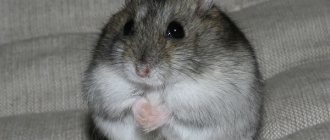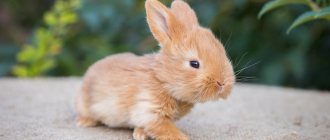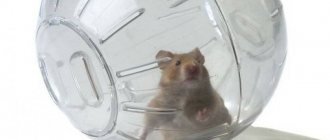Here is information about the pros and cons of keeping rabbits as pets. All information was compiled based on my and other people's life experiences. Be sure to read the entire page before purchasing a rabbit. This is in your interests and the interests of the animal, not to mention your household. And only after that decide whether to have a rabbit in an apartment or a private house.
Advantages:
- They get used to people and many pets, including cats and dogs.
- Dwarf rabbits are small, do not take up much space, eat little, and have little odor.
- Beautiful, fluffy, soft.
- They love to be stroked and, in turn, lick their owners.
- They cost less than the same chinchillas.
- A rabbit can be litter trained.
- A rabbit can be trained to walk on a harness.
- Rabbits love to play, and if you try, you can stop them from chewing wires and wallpaper.
- Rabbits are generally sociable.
- If you also have a cat, you can watch and participate in their games. True, it depends on the characters of the cat and rabbit.
Flaws:
- Rabbits have a lot of their own characteristics, including their content - they are worth knowing inside and out.
- The smell, and a very strong smell if you rarely clean the cage.
- The larger the animal, the more it eats and smells.
- Under no circumstances should you keep a rabbit in the same cage as a guinea pig.
- Rabbits love to chew wires and tear wallpaper; you still need to be able to wean them off this.
- It is more difficult to train a rabbit to use a litter box than a cat, but you will need to do this if you want to let him out of the cage and at the same time protect the apartment from white spots and feces.
- Dwarf rabbits are more susceptible to disease and are significantly more expensive.
- Decorative rabbits are larger in size than dwarf rabbits and have more odor.
- Rabbits are much more susceptible to disease and risk of injury than cats and dogs.
- To keep a rabbit you will need to buy various items, such as: a cage, a drinking bowl, a feeder. They need to regularly buy hay and dry food in granules.
- The temperament of rabbits, especially female rabbits, can be explosive. So, during the rut, one decorative rabbit dragged a huge Persian cat by the tail and pulled out tufts of fur from him, and when she was put in a cage, she shook the bars with her paws, chewed them with her teeth, and threw bowls around.
- If a rabbit doesn't like you sticking your hands into its cage, it may strike with its clawed front paws, and some rabbits may even bite.
- Have you heard the rabbits hissing and growling? If you're unlucky, you'll hear it.
- As I said above, you need to know the characteristics of rabbits. So, for example, they can scare an ignorant owner by falling on their back and rolling their eyes, but, by the way, they do this out of a great mood and pleasure. Or, for example, if the baby rabbits have diarrhea, then they must be urgently taken to the veterinarian, because without professional intervention they may not live even two days.
Is it worth having a rabbit in an apartment, pros or cons?
It is not human nature to listen to other people's opinions. How much did you listen to your mother, and then say, Mom, you were right, and even more so the opinion of Internet advisers on choosing animals. Meanwhile, rabbits are exotic animals for apartment keeping, and exotic animals require special knowledge. Therefore, read our advice, and then decide for yourself whether you are ready to take responsibility for a small living creature.
So, the topic of today’s review is decorative rabbits: pros and cons. How difficult is it to care for a small pet, how to feed it and what should you be wary of? Read about all this right now.
How to avoid diseases
In a greenhouse, it is impossible to achieve a level of sanitation comparable to cage housing. Feces and urine scattered throughout the area contribute to the development of coccidiosis. Therefore, animals must be given coccidiostats in a timely manner.
In winter, rabbit breeders fear frost. But he is not afraid of rabbits. And the greenhouse does not warm them, but only protects them from the wind. But due to the design features, excess moisture is created inside. Especially when there are a lot of animals. Such conditions contribute to the development of many diseases. The situation is aggravated by the evaporation of urine and the increased concentration of ammonia in the air. There must be ventilation.
When kept for walking in winter, it is better to plant only females in the greenhouse. The presence of males leads to indiscriminate mating. And if there are several of them, it leads to constant fights. Therefore, males must be left in cages.
If you spend time once and adapt the greenhouse to keep rabbits, you will get a full winter run for all subsequent years. This means you use the favorable summer time to maximize the reproduction of your herd. At the same time, after winter you get well-fertilized soil and high yields in summer.
Decorative and productive rabbits
Rabbits can be wild or domestic. Read all about wild rabbits. Domestic rabbits are divided into two types of economic use.
- Productive breeds are grown exclusively for meat, skins, and fluff.
- Decorative breeds and their varieties are dwarf and are raised only as pets.
In 1912, zoologists divided rabbits into two orders - rodents proper and lagomorphs. Since that time, rabbits, hares and pikas began to be classified as rodents (lagomorphs). So don't call rabbits rodents.
Read more: Why rabbits are not rodents
Sources
Photos
kaninchendorf.dreipage2.de
Advice and information
https://www.kaninchenwiese.de (Site about rabbits, as an accompaniment to books about rabbits) https://tmp.tierschutzverein-freiburg.de/informationen/umgang-mit-tieren/kaninchenhaltung.html (Union for the Protection of City Animals Freiburg, Germany) https://www.sweetrabbits.de (partner organization of krolikdoma.com for the protection of rabbits and educating owners about the content that meets the natural needs of rabbits) https://www.heimtierpraxis-berlin.de – veterinary clinic for rabbits and rodents of the city of Berlin, Germany https://www.braunsfeldklinik.de - veterinary clinic of the city of Cologne, Germany https://www.tierklinik.de/tier-abc/kaninchen - veterinary online portal, Germany https://www.djgt .de/system/files/57/original/Stellungnahme_DJGT_Kaninchenhaltung.pdf – German Law Society for Animal Rights
When you can’t get a decorative rabbit, pros and cons
It is strictly forbidden to purchase rabbits.
Don't get a rabbit as your first pet. Do not get a rabbit to play mother-daughter games for girls 10-12 years old. Don't let your first experience of future motherhood end with the death of your pet. The risk of death is very high. It's better to adopt a kitten from a shelter. This will be the best example of kindness for the expectant mother. Cats, physiologically, are much closer to people. They have the same type of digestion, they are smarter, communicate easier with people, and are more adequate.
Teach children responsibility and kindness, and not to fulfill the child’s every whim. Read the great Ukrainian and Russian teacher V.A. Sukhomlinsky.
Start at your discretion, but remember the characteristics of long-eared animals at home.
- Do not have pets under the influence of momentary sympathies.
- If you don’t know, the second most frequently asked question from lovers of decorative rabbits is the question in the search engine: why do rabbits smell? I’ll get ahead of myself and say that the smells are overfeeding the pet with treats.
- Not many people know that eating feces in rabbits is a physiological feature that cannot be weaned off. In all lagomorphs (lagomorphs), cecotrophy is a physiological feature of digestion. The rabbit is not a rodent; it belongs to an order parallel to rodents.
- For young families, an exception: if one of the members has been the owner of the animal for a long time. Build your relationship first.
- If you plan to have a little one. Definitely, the animal will interfere and distract the young mother from new and difficult responsibilities; do not torment the mother and the animal.
- One of the family members is against pets. Avoid unnecessary scandals with loved ones and family.
- Like a thoughtless purchase, at the child’s first request. Parents will take care, and the child, instead of kindness, will learn to shift his worries onto the shoulders of others. Or immediately take on this burden and explain to the child that this is not his whim, but the decision of the family council.
- The area of the home is so small that there is nowhere to turn around. Sometimes our housing is so small that its area resembles an enclosure for a large dog.
- Rented housing is also not an option. Rental conditions may change; constant moving does not contribute to normal conditions for the pet.
There are other options, they can be listed for a long time, based on the characteristics of each family, and determine for yourself the pros or cons of a decorative rabbit in the house. But if you are determined to get a rabbit, then read on, perhaps you will only become stronger in your desire to care for a cute bunny.
Some notes from the owners' experience
It is the reviews and experience of owners of furry animals that help them decide whether to get a rabbit or not. A few recommendations:
- when traveling with rabbits, you need to prepare the same package of documents as when transporting cats/dogs (a passport with vaccination records and a “fresh” certificate from a veterinarian are required);
- Rabbits are social animals and if the owners are constantly at work, then the animal may not fit into the family, will be scared of everyone and may even bite. Some owners note that the rabbit recognizes one owner and is reluctant to go into the arms of other people;
- If there are small active children in the family, then it is not recommended to have a small pet. You can purchase an animal for a child aged 10-13 years. Small children will not be able to seriously care for the animal and may frighten it;
- rabbits are calmer than female rabbits. Although this feature is also determined by the character of the individual. Fluffies get along well with other pets;
- owners like that the rabbits are not allowed to walk outside, and that minimal time is required for servicing the animals and cleaning the cage.
It is possible to train the animal to respond to its name and to its litter box. It is worth remembering that a rabbit is an animal that bites and is capable of throwing itself in the face. They also take into account the timid nature of animals; they should not be left alone for a long time. Cute creatures evoke affection in both children and adults
Animals require a minimum of care and always respond to affection and attention. In order for animals to fully develop, it is necessary to choose the right diet and arrange a suitable place for keeping them.
An animal is not a child's toy
This is the first thing to realize. Despite their miniature size and usually affectionate nature, rabbits will require attention, affection, special food, and special care products.
Dwarves are sometimes very aggressive, even more so than giants
Before you get a rabbit at home (and this must be explained to your children), you need to take care of the mandatory conditions for keeping a dwarf rabbit at home:
- spacious cage;
- the rabbit owner has free time when he needs to take his pet for a walk;
- proper nutrition and veterinary care;
Rabbits do not tolerate moving and travel well. How to transport rabbits and other animals within the country and abroad, find the section veterinary certificate form 1 veterinary Rosselkhoznadzor. It is clear that it is difficult to understand the cavalcade of documents, but find your region in the search at the top of the page of this site. If necessary, contact inspectors in your region by phone. We are obliged to help you. In any case, you will know what requirements need to be met when crossing the border with an animal and more. Perhaps the information from the site will help you make a choice when buying decorative rabbits. Rabbits can be long-haired or short-haired.
Breeds of dwarf rabbits
The painstaking work of breeders has made it possible to develop a wide variety of rodent breeds. Among them:
- Dutch rabbit;
- fold-eared Ram;
- Angora rabbit;
- lion breed rabbit;
- shorthaired colored.
Dutch rabbit
The Danish rabbit is one of the ten most popular types of rabbits. Compared to other breeds, the Dutch is a giant. Its weight can reach two and a half kilograms.
It has a large wide head, a rounded body, straight ears and short front legs. The Danish rodent has a distinctive feature - a white wedge from the ears along the nose.
With proper care, such an animal can live up to 10 years. In addition, it will not bring much trouble to the owner. The animal has a balanced character and a tendency to learn.
Lop-Eared Ram
The Lop-Eared Ram is the leader of all rabbits. This is the most popular among all dwarf rodents. Its weight reaches one and a half kilograms.
The Ram's head is only half the size of his body. The rabbit's muzzle is shortened, its eyes are set wide.
The main feature that will not allow you to confuse the ram with other species is the ears. They hang a couple of centimeters below the jawline.
Just like the previous one, this species is quite friendly and willing to be trained.
Angora rabbit
The Angora rabbit is very similar to a small fluffy ball, from which the ears and nose barely peek out.
The weight of the rodent is small - only 1.3 kilograms.
The fur is long. Quite soft and pliable
Please note that this type of fur is very prone to tangling, which is not good for the animal. The ears are straight, with tassels at the ends
Such an animal does not have a tendency to aggression.
Lion breed rabbit
The lion breed rabbit got its name because of its resemblance to the king of beasts.
The rabbit has a small body with a wide shoulder, which is covered with small hair. Weight can reach one and a half kilograms.
The head is not large, has a voluminous mane. Ears are straight. The fur on the chest can reach 7 centimeters.
The Lion Head has a good-natured character. In some places the animal may show timidity. The animal is very active, so it is worth taking care of a spacious cage.
Shorthair Colored
The colored rabbit is most suitable for keeping in apartment conditions.
The animal is small, the maximum weight does not exceed one and a half kilograms. But the body has a compact shape.
With proper care and upbringing, a short-haired rodent is calm and kind.
Is it worth having a rabbit for children? Pros or cons?
The kids really like cute miniature creatures. However, the child needs to understand that squeezing a “living toy” will have to be done carefully. It is necessary to take into account not only the desires of the child, but also the desires of the rabbit; although he is small, he is a living creature.
The rabbit does not bite often - more often it just hits the offender hard with its hind legs
Photo. Before buying a rabbit, we present the picture like this
- At the slightest change it can become aggressive.
- Baby rabbits should be purchased only from trusted breeders, or at a pet store.
What to feed and how to drink
A rabbit is a pet that does not require a varied diet. The animal's diet includes:
- Compound feed is a balanced feed containing a full range of essential vitamins and minerals. Children are given 1 tbsp. spoon 3 times a day. Adults - 2 times a day, 1–1.5 tbsp. spoons.
- Hay is a must-have product for grinding teeth. The leader in protein content is nettle hay.
- Twigs of pear, apple, willow, aspen and poplar. In summer you can give branches with foliage, in winter - coniferous branches.
- In summer, instead of hay, they give a mixture of dried herbs - yarrow, chickweed and common hogweed. Suitable dried plants include stems of calendula, asparagus and hops.
- Greens - quinoa grass, dandelion, wheatgrass, rhubarb leaves, clover.
- From garden plants - leaves of radishes, carrots, turnips, strawberries, Brussels sprouts and Savoy sprouts, salads.
- Vegetables - tomatoes, zucchini and cucumbers without seeds, carrots and turnips.
- Fruits - apples, pears, bananas, melon and watermelons in small quantities.
You cannot give:
- Exotic fruits.
- Branches from sweet cherry, cherry, walnut, buckthorn, apricot, peach.
- Potatoes, nuts, red beets.
- Legumes in large quantities.
- Red, white and cauliflower.
- When preparing hay, make sure that there is no celandine, hemlock, datura, or tansy in it.
- Products containing carbohydrates - pasta, crackers, bread and confectionery.
- Candy, cookies, sausage and other human delicacies.
The drinking bowl should always have clean, preferably boiled and cooled water, which must be changed every day.
Did you know? When eating food, a rabbit makes two chewing movements per second, that is, it makes 120 jaw movements in a minute.
Can a decorative rabbit be huge?
It is believed that a home decorative pet must be a small animal. This is wrong. Maybe you are looking for a huge decorative rabbit. Then the old breed Flanders rabbit is your choice. The history of breeding this breed is very interesting and full of mysticism. Flandre is the largest rabbit, with an average weight of 12 kg. Flanders are common domestic rabbits in the United States that are bred as pets. In America, a program has been developed to teach children how to care for animals using the example of Flanders. The main breeds of giants, rabbit and ram, including dwarf breeds. The Rex breed group is interesting.
Is it possible to teach a rabbit to pee and poop in the same place?
If the rabbit lives only in a spacious cage, then it is possible to train it, since these animals are very clean and usually choose a secluded place in their home for their excrement. The right tray is that very secluded place. However, remember, when released from the cage, he will most likely pea incessantly and this is also the norm, this is how he “confuses” his tracks from predators.
Are you ready to tolerate a poor animal for 5-7 years? If yes, then let's talk about feeding
Is it worth getting a chinchilla: all the pros and cons
Chinchilla has its own rules of keeping. Therefore, the future owner needs to think carefully about whether he will be able to carefully care for such an exotic animal. Unlike other unpretentious rodents, this pet needs constant attention and financial expenses. A chinchilla is less active than a cat or dog, but requires much more attention. Among the main advantages of such a friend are:
Chinchilla is an exotic animal
- no need for walking;
- cleanliness and minimum of unpleasant odors;
- high life expectancy (about 10 years);
- non-aggressive behavior and learning ability;
- the animal's cheerful and playful disposition.
But it’s worth taking into account the downside of keeping a chinchilla. For example, tangible flaws of such a pet often include:
- expensive accessories and place to live;
- shortage of qualified veterinarians;
- noisy behavior at night;
- increased sensitivity to temperature.
There is an opinion that chinchillas do not like contact with their owners, touching and excessive caresses. But this is not so: it all depends on the mood of the animal and its character. At times they love to sit on your hands and ask to be scratched.
Chinchillas have thick and soft fur
Poor care of a rodent immediately affects the pet’s well-being. If, due to financial restrictions, it is impossible to provide them with a spacious cage or high-quality food, the animal will become lethargic, will often get sick, and its lifespan will be reduced to 5-7 years, if not less.
And if you have children, then you should also supervise the interaction between children and your pet - careless games can harm the rodent and cause stress. These animals are not fans of frequent squeezing and noise, so they will feel uncomfortable next to a child, especially an infant. A chinchilla should only be owned by those who are willing to provide it with suitable conditions and pay plenty of attention.
What food does a decorative rabbit need?
The rabbit comes to the feeder very often during the day: from 20 to 60 times. No, you can fill the feeder once a day, he just needs to always have a feeder full of food. Rabbits salivate constantly, and not like other animals, before and during meals. In addition, his front teeth - incisors - are constantly growing, he needs to grind them down, or rather, he grinds them down himself when he gnaws on hard twigs. Otherwise, a disease called malocclusion develops.
The rabbit is a granivorous animal, and not a ruminant like a cow. The cow has four stomachs and can digest low-nutrient grass. A rabbit, like a cat and a dog, has only one stomach. However, in the diet of a decorative rabbit, approximately 70% of the food is hay, grass, and twigs. Grain feed in the diet of a decorative rabbit is no more than 30%. They purchase grain feed at a pet store or make their own mixtures of grains. Grain is better absorbed in crushed form; coarse grinding is required; grain ground into flour is not allowed to be given to rabbits.
Cecotrophy is a way to assimilate grass and grain as completely as possible, an analogue of ruminant rumination
Photo. But what can happen if you don’t give a decorative rabbit, for example, twig food?
Conditions of detention
To properly keep a rabbit in an apartment, you need to know certain nuances:
- cannot tolerate overheating;
- direct sunlight is harmful;
- ideal temperature - +20 °C;
- air humidity - 50%;
- they are afraid of drafts.
Keeping a decorative rabbit in an apartment requires the presence of a spacious cage or enclosure with all the necessary equipment for normal life. Read about the most popular breeds of decorative rabbits.
Why is it not recommended to keep them in cages?
For a rabbit to be healthy, movement is very important for it. A cage up to 1 meter in size cannot provide the necessary territory for active running, so the pet must be allowed out for walks, during which the animal:
- stretches paws;
- develops coordination of movements;
- reduces weight;
- receives disease prevention;
- communicates closely with the owners.
Requirements for an enclosure for rabbits in an apartment
For an active life, a rabbit needs an enclosure where it can run and jump at any time. The area of this structure must be at least 2 square meters. meters per animal. It is advisable to place the enclosure along the wall, in a place where there will be no direct sunlight and no draft.
To save space, this structure can consist of several floors. The floor of the enclosure should be soft; in order to avoid diseases of the animal’s paws, it is necessary to lay a rug made of natural material on the floor. The enclosure needs to be cleaned at least once every 7 days.
Unfortunately, rabbits often get sick, so the owner of this animal should know about common diseases of decorative rabbits.
Security measures
Keeping a dwarf rabbit at home involves protecting it from various dangers, in particular:
- All wires must be placed in boxes or raised to a height beyond the reach of the pet.
- Eliminate the possibility of going to heights.
- Put the clothes in the closet.
- Instead of newspapers and magazines, give out a cardboard box.
- Eliminate cracks behind the cabinet where a rabbit can crawl.
- The balcony door must be locked if the balcony is not glazed.
How do rabbits get along with other animals?
The question is controversial whether it is worth starting a zoo at home from different species of animals that are antagonists in nature. If you have even the slightest idea about animal psychology, start one. If you have no idea about competition in the animal world, hierarchy, who to feed first, who to feed later, who needs to be petted, who needs to be reined in. Then don't start it. Remember that keeping a rabbit at home is more difficult than keeping dogs and cats.
Photo. Oh, trouble, trouble! The owner also decided to get a rabbit. Vasya, maybe we can eat it, huh?
Is it worth getting a rabbit in a city home or apartment? If you have pets that can eat rabbits in the wild, think carefully.
For example.
- It is possible to keep a rabbit together with reptiles if snakes and other reptiles live in a secure terrarium.
- Dogs. A predator can easily provoke an “interspecies” scandal and eat the baby rabbit on the very first day of purchase. It is usually not recommended to have rabbits in homes where there are dachshunds or other dogs designed for burrowing.
- Cats. These animals are very jealous, and underneath the outward indifference and play there may be a showdown. There are known cases of cats leaving home when a competitor appears.
- Birds. Shared content is almost always allowed. Birds and rabbits are animals of different elements (heaven and earth).
Facts about rabbits
- They are often confused with hares, but this is not true. There are many differences between them, despite the fact that they are related in the biological sense.
- Wild rabbits can reach speeds of up to 50-55 km/h when running.
- All 16 species of American rabbits live in forests and swamps and do not dig burrows. In addition, they are excellent at climbing trees. And outside of North America, all rabbits live exclusively in burrows and do not know how to climb trees (interesting facts about North America).
- Rabbits and rodents like hamsters and rats share a common ancestor that lived many millions of years ago. However, they still do not belong to rodents.
- North America is home to more than 50% of all rabbits in the world.
- Wild European rabbits dig deep and branched burrows, which sometimes combine into entire underground cities.
- American rabbits are solitary, while all other species usually live in groups.
- In the wild, rabbits are hunted by all and sundry. The only thing that saves them from extinction is that they reproduce at an incredible rate.
- In case of danger, these animals prefer to run away, but if they are driven into a corner, they go for broke and try to defend themselves. With a blow from its powerful hind legs, armed with sharp claws, a harmless rabbit can easily kill or seriously injure a predator.
- They chew very quickly. When a rabbit feeds, its jaw makes an average of two chewing movements per second, and it can chew like this for a very long time without getting tired.
- The weight of adult individuals of the largest wild species usually does not exceed 3.5-4 kg, but domestic rabbits can weigh up to 10-11 kg.
- There were no rabbits in Australia until they were introduced there in the late 18th century. Since then, they have proliferated monstrously and become a serious threat to the ecosystem. They were shot, protective fences were erected against them, and in the middle of the 20th century a special virus was spread among them, which reduced their population to acceptable levels (interesting facts about Australia).
- Due to the fact that rabbits are easy prey, on average they live in the wild for no more than a year. But their domestic species can live 10-12 years if they are provided with appropriate care. The official record is 19 years.
- Their hind legs allow them to jump up to 2-3 meters in length and 1-1.5 meters in height.
- Nature has adapted rabbits' eyes for excellent visibility so that they can always see a sneaking predator. So, rabbits even see what is happening behind them without turning their heads.
- Like people, these animals can actually die from fear if they are particularly frightened.
- Rabbits' foot pads may become sweaty in hot weather.
- Female rabbits have a double uterus, which allows them to simultaneously carry two generations of offspring, from different males.
- On average, rabbit ears are 8-12 centimeters long, but a domestic rabbit whose ears reached a length of 80 centimeters was included in the book of records.
- Some of their breeds become sexually mature as early as 3 months of age. This partly explains their fertility.
- Rabbits give birth to many offspring at one time, but the female herself usually cannot produce all the newborn rabbits. If she gets help, they can all survive. The official litter record is 24 rabbits at one time.
- These animals drink a lot of water. Thus, a rabbit weighing a couple of kilograms can drink more than a dog five times its weight.
- During the era of sailing ships, in the 17th and 18th centuries, sailors often released rabbits on deserted uninhabited islands. This was done so that if people ended up on the island as a result of a shipwreck, they would have a source of food.
- The Aztecs discovered alcohol when they found rabbits drunk after eating some fermented cacti.
- In the Australian state of Queensland, it is legally prohibited to keep rabbits, even ornamental breeds. Violators face a fine of 30 thousand Australian dollars.
- There are about 17 thousand taste buds on a rabbit's tongue.
- Rabbits actually have many more teeth than meets the eye - as many as 28.
Rabbit and man
Wild rabbits live in groups and do not tolerate loneliness well. This also applies to decorative rabbits. Believe it or not, it is important for your pet to feel like a member of the group. Such a group could be another rabbit, a family of people, a person. A rabbit may consider animals of other species that were raised at the same time as its family. The rabbit needs to determine its place in the pack, who to obey, who to dominate. Ignoring the animal’s innate reflexes ends in the latter’s unmotivated aggression.
Read more: Why does a rabbit bite?
Is it possible to keep a rabbit at home?
Those varieties that are specially raised for meat can show aggression towards humans, while decorative ones have a peaceful character and quickly get used to hands.
The main obstacles to keeping rabbits
First of all, you need to understand that a decorative rabbit at home requires care. Regardless of the breed, the rabbit loves freedom. Without periodic walking, he will be depressed and even the largest cage will not be able to replace his free movement. You need to think in advance whether it will be possible to periodically release the animal into the wild - then it will be as friendly as possible to people. The walking area should be isolated from any things that could be chewed. Wires, wooden furniture legs, shoes, floor carpets - these and many other objects can become “prey” for the eared one.
Important! Small children and untrained pets can create problematic situations when keeping rabbits. Children under 7-8 years of age are highly discouraged from making physical contact, as eared ones are very sensitive to touch and require careful handling
At what age is it better to buy a rabbit?
- Before purchasing, you must check the age of your pet. Do not take baby rabbits immediately after weaning from their mother. The approximate age suitable for purchasing a baby rabbit is 3-4 months. This age corresponds to 10-12 years in humans.
- Until 3-4 months, all necessary vaccinations and antiparasitic treatments are given, which is mandatory for decoratively bred breeds that come into close contact with humans. Subsequent vaccinations are given or not given based on the likelihood of contact (direct or through owners) with other rabbits. Rabbit infections are specific, so contagious diseases of dogs or cats are not dangerous for rabbits.
Rabies is dangerous for rabbits only when bitten and the saliva of a sick animal gets into the wound. There is a possibility of rabbit rabies in rural areas; in the city the danger is purely hypothetical. Although, to be honest, cases of rabies in rabbits are extremely rare, more often domestic animals become infected through the bites of foxes (dogs, cats, cows).
Having figured out at what age to adopt a fluffy (or smooth-haired) pet, you need to prepare a spacious cage, a supply of food, twigs that can be chewed to grind down teeth, and a tray to which the rabbit will need to be accustomed. It is not recommended to take adult rabbits, since the animals already have established habits, and they react to shift changes with illness, depression, and even sudden death.
When should you contact a veterinarian?
Warning signs: excessive nasal discharge, sneezing, tears, runny nose, swollen eyelids, pus, grinding of teeth, poor or no appetite, distended abdomen, lack of bowel movements or liquid feces, formations and tumors on the body, bald spots on the coat and copious amounts of it. hair loss, dirty fur, wet face, rapid breathing and heart palpitations.
Each of these symptoms may be the result of an animal illness. Once any of these signs are detected, the rabbit must be taken to a veterinary clinic immediately, because the disease spreads quickly and death can occur quickly.
Who to choose, boy or girl
There are pros and cons for males and females. Care and maintenance for individuals of different sexes is not particularly different. Females, like males, can write by. Rabbits mark territory. Not smelly glands on the chin, smelly glands under the tail. Friendliness and affection, as well as behavior, depend on the genetic component, and not on the sex or species difference of the animal. Raising a rabbit can be done with effort, health monitoring, and genuine friendliness, which animals pick up on.
First meeting
A rabbit at home is not a toy for others. From the first minutes you should not insist that the decorative rabbit play with you and willingly go into your arms. This will take some time. How many? It depends on the character of the pet: it is as individual as that of people.
First, put the animal in a cage and let it get comfortable there. When he stops being afraid, eats and drinks without fear, and begins to show interest in the “outside world,” you can move on to the next stage.
Try luring your pet with a treat. But don’t push him into the cage (this is the animal’s territory!), but keep him in front of the door. When the animal is no longer afraid to take food directly from your hands, while feeding, begin to slowly stroke its head.
Always try to talk to your decorative rabbit and call it by name. Just not loudly - long-eared animals do not like loud sounds (in the beginning it is better to do it in a whisper). Gradually the animal will begin to respond to your voice and respond to your name.
What-what did you call me?
How to determine the health of a rabbit before purchasing
You need to check the condition of your future pet before purchasing. It is advisable to purchase rabbits not from hand, but from pet stores, although they can deceive you in a store. Don't trust sellers, trust your eyes. But if the animal breeder is trustworthy and can provide all the necessary documents and confirm vaccinations, listen. There is no particular reason for breeders to deceive. Once he deceives, then few people will take animals from him.
If there is no one to advise, pay attention to the following points:
- Eyes. The eyes and nose should be clean, without signs of any discharge;
- Activity. Little rabbits should be active and inquisitive, sniff and inspect the territory, and easily make contact during inspection;
- Fur. A good indicator of health is clean fur, no bald spots, bald spots, combs or scratches;
- Appetite. A good appetite for a baby rabbit is the key to health.
- Ears. The inside of the ear must be clean
I almost forgot. At the age when I advise you to buy a pet, see point 3. The rabbit sheds.
Pay attention to this, consult with the breeder, and avoid the first experience of unnecessary and useless treatment. Watch the rabbit molt. Why does hair fall out, why does one go bald.
Do not pay attention to the temperature of the rabbit's ears, dryness or wetness of the nose. If you are not a specialist in the field of veterinary medicine, you should not pay much attention to this indicator; you can easily make a mistake. Hot ears and a dry nose of a rabbit are of clinical significance if the baby has no appetite and constantly lies in the far corner of the cage.
Breeding methods
In Russia, rabbits are bred in agriculture on an industrial scale, as well as at home, and using the MIACRO method.
Industrial breeding
Large farms house thousands of animals. There is appropriate equipment for rabbit breeding. Rabbits are housed in specialized cages, which are located in ventilated buildings with controlled humidity and air temperature.
All care processes are automated. Breeders are engaged in breeding here, and veterinarians monitor their health.
The purpose of industrial breeding is to raise animals to produce large volumes of quality products for sale.
Breeding at home
Home breeding of rabbits is not as numerous as on farms. But the breeder can also make a good profit. A female rabbit can produce up to 30 babies a year, which is about 60 kg of useful meat.
It is better to choose meat breeds for your home, because they are less demanding to care for, calm, and highly fertile.
Breeding according to the Mikhailov method
Russian professor Mikhailov invented a new method of breeding rabbits - MIACRO (“Igor Mikhailov’s Accelerated Rabbit Breeding”).
The idea is to minimize human-animal contact using special mini-farms. These are structures where automatic supply of food and water is provided, and optimal air temperature and humidity are maintained. With minimal contact, the incidence of disease decreases, activity and fertility increase, and the rabbits quickly gain weight.
In addition, long-eared animals do not experience constant fear, which is provoked by a person when opening a cage. Rabbits “according to Mikhailov” by 4 months gain weight up to 4 kg.
Breeding animals in winter
If rabbits are kept indoors, they must be heated in winter. If cages with animals are placed outside, when it gets colder they need to be insulated, especially the floor. Cages with queen cells (places for breeding) are covered with straw, mats, and plywood. In severe frosts, it is still recommended to take animals indoors.
Rabbits are given increased nutrition and fortified feed. It is worth noting that cubs born in winter are stronger and grow faster and gain weight.
Diseases of rabbits for which there are vaccines
To be fair, it should be noted that infectious diseases of rabbits, including decorative ones, are not fatal to humans. There are no known cases of rabies in domestic rabbits, although rabbits are susceptible to the rabies virus.
When traveling on trains and planes, anti-rabies (rabies) vaccination is mandatory.
Infection of rabbits from hunting dogs is unknown. Rabbits do not suffer from tick-borne encephalitis, Lyme borreliosis and other infections transmitted by ixodid tick bites.
When a rabbit is bitten by a tick, fatal allergic reactions are possible, but they are not infectious.
It is necessary to vaccinate an ornamental rabbit only if the animal is a breeding animal, participates in exhibitions, or the owner of the animal has contact with farm rabbits.
It makes no sense to vaccinate a rabbit living in a metropolis where there is no contact with other susceptible relatives.
Vaccines against the following diseases have been developed for rabbits:
- myxomatosis is an infection transmitted by mosquitoes, dangerous in rural areas where there are rabbit farms, people do not get sick;
- rabbit viral hemorrhagic disease (RVHD), sometimes called rabbit distemper, does not affect people;
- lichen (dermatophytosis), rabbits and people get sick.
- pasteurellosis in rabbits, people get sick.
Typically, complex vaccines are used for rabbits, which contain protective antigens against all diseases. Sometimes I use vaccines against one or two infections. Your veterinarian will tell you the pros and cons of each vaccine for your animal.
Is it worth getting a chinchilla?
Like any other animal, the chinchilla has its own characteristics and maintenance rules. Anyone who wants to keep this rodent at home should think about whether it will receive proper care.
Do chinchillas make noise at night?
Historically, chinchillas have been active at night. That's what they call them - twilight animals. When choosing a pet, it is worth considering the fact that its activity will increase in the evening. But during the day he will happily rest. This happens more often in young individuals. Older ones who have offspring are calmer.
Does the animal have an unpleasant odor?
Almost all pets have one or another smell that is unusual for us. When you enter any apartment, you can immediately tell by the smell whether someone lives here or not. Chinchilla, perhaps, will be an exception here. The animal itself does not have an unpleasant odor. Chinchilla is very clean. And if the owner himself cleans the cage on time, changes the bedding, and monitors the freshness of the food and water, then the problem of odors will not interfere. Otherwise, odors will be absorbed into the animal's fur.
A person may be allergic to chinchillas
Is it possible to be allergic to a pet?
Chinchilla fur causes allergies no more often than the fur of any other animal. Therefore, if a person is predisposed to allergies, then it is better to go to the store, hold this animal in your hands for a while and see how the body reacts.
Preventive measures will help prevent the occurrence of an allergic reaction:
- when cleaning the cage, it is better to use a protective mask to avoid dust from fur and filler entering the body;
- Wipe the cage and everything in it more often with a damp cloth or rag.
- it is recommended to replace store-bought filler with regular sawdust;
- bathe the animal in a room where there is good ventilation.
How dangerous are chinchillas?
May cause allergies.
They can infect skin lichen.
They can carry various infections.
It is necessary to maintain cage hygiene, wash your hands after interacting with your pet, and give the animal sand baths more often.
Is it possible for families with children to have a chinchilla?
It is important to understand that any pet is a living creature. Therefore, children should know that animals must be handled with care.
These rodents do not like to be cuddled or pressed hard. The chinchilla may be scared or in pain. She may bite in self-defense.
If the child is very small and, due to his age, is not yet able to understand such things, then it is better to avoid contact with the rodent. If the child just likes to watch animals and will not disturb the pet’s peace, then the child will not become an obstacle to buying a rodent. Only under these conditions can an animal live happily ever after in a family.
Will other pets be a problem?
These rodents spend most of their time in a house, in a cage. But sometimes the owners let them go for a walk. If supervision is carried out, then no special problems should arise. Chinchilla gets along well with other types of rodents: rabbits, guinea pigs, hamsters.
Remember that with any neighbor, division of territory is inevitable. The opponent will cause constant stress to your new pet. If animals living in the house walk outside, they can bring infection or pathogenic bacteria to the rodent. But if you place smaller relatives, for example, small mice, in a chinchilla’s cage, then in this case you should fear for their lives.
Do you have other animals in the house that roam outside? Poll Options are limited because JavaScript is disabled in your browser.
Chinchillas have their pros and cons
Contagious diseases of rabbits for which there are no vaccines
- Coccidiosis is a parasitic disease caused by microscopic parasites that inhabit the intestines and liver. There is no vaccine. Treated with chemicals, instructions for veterinary medications in packaging convenient for decorative rabbits.
- Rabbit worms. Helminths are more common in rabbits in rural areas. One treatment is enough, upon purchase. Then repeat only if there have been contacts with other rabbits (other animals do not get sick). Parasites of cats and dogs are not dangerous for rabbits, since rabbits do not suffer from meat-eater diseases.
- Tick-borne diseases of rabbits. There are two known diseases. The first ear mite is called “Psoroptosis” - microscopic mites in the ear, mainly in young animals, transmitted from the mother. The second is called “Cheyletiosis” - mites on the body - redness and thickening of the skin on the neck. Both diseases are easily treated. Not dangerous for people.
Health
Rabbits by nature have poor immunity and often get sick. Animals tolerate infectious diseases the worst.
One of the most dangerous diseases is myxomatosis. The disease is incurable; it can only be prevented through preventive vaccination. If a rabbit gets sick and the vaccine has not been given, it must be immediately euthanized and the body burned. Symptoms of myxomatosis are swollen eyelids, ears, genitals, conjunctivitis. Bald patches and sores may occur in the affected areas of the skin.
Another dangerous disease is coccidiosis. The disease poses the main threat to small rabbits up to 3 months old. Symptoms: bloating, poor appetite. Choosing quality food and clean drinking water will help protect against disease.
Rabbits live for about five to seven years, but in the right living conditions the animal can live up to 12 years.











